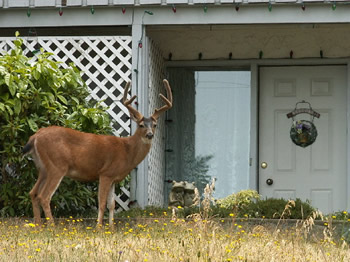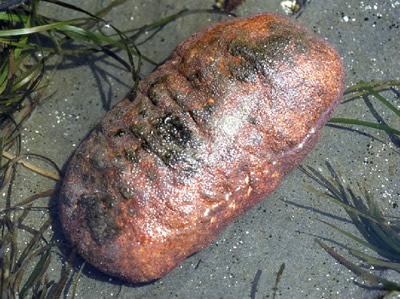| Dereila Nature Inn Home > Lagoon Trail > Marine Life Guides, Articles, Trivia and More! > A Stroll Along the Beach |
| |
A Stroll Along the Beach - Page 1 |
| |
On many occasions you do not have to go far to enjoy the wonderful nature that is all around us, in fact, sometimes it comes to you just like this friendly Mule Deer!
Enjoying nature in the wild and natural areas is much more pleasurable than watching it nibble in your flower beds and chomping on your shrubs. Those of us lucky to live by the ocean find that the beach is a fabulous place to explore as it's ever-changing.
Who knows what you'll find after the tide has gone out, especially the violent tides of spring? Among the debris washed up on the shore, there is a fascinating world of life hiding or hanging-out in the tidal pools, clinging to rocks and driftwood or simply strolling along. |
__ |
 |
|
|
|
 |
This Gumboot Chiton, Cryptochiton stelleri, has been torn away from the rocks. These creatures can actually grow up to 13 inches (33cm) long and are considered the "Giant of Chitons." They use their large muscular yellow foot to cling tightly onto rocks and creep around feeding on algae. Stranded on the beach after a storm they are vulnerable until another tide washes in and sweeps them away to safety.
| |
Somehow, with this constant pounding on the rocky shores, numerous animals manage to make this their home. However, with the on-going conflict for space and food, many have to adapt in this very severe habitat, finding new zones in which to live and feed.
Out where the crashing waves are at their peak and only accessible or visible by humans only at the very lowest of the tides, live the sea palm plants. This is where the Sea Palm, Postelsia palmaeformis, (right) anchors itself to the rocks where no other plant can survive.
These miniature "palm trees" flourish in this harsh environment, with their rubbery stems bending with the forces of the waves. In this inhospitable environment, they still manage to grow up to 20 in (51 cm), securing themselves by sending root-like extensions into rock crevices.
|
C |
 |
|
| |
 |
In the calmer part of the shore, exposed in a low tide, the rocky world of the tidal pools begs to be explored. This is the home of a variety of plants and animals which strive to be protected from predators, dried out from the glaring sun or washed away. Here you'll find sea stars, urchins, barnacles, crabs, kelp and anemones like these Aggregating Anemones, Anthopleura elegantissima.
These creatures feed on organisms and small crustaceans trapped in their stinging tentacles, which are often withdrawn when exposed. Algae live in the anemone's tissues, giving them their green colour. |
| |
 |
Predators abound in these tidal pools with perhaps the most common and recognizable one being the sea star, with an amazing ability to attack so many different creatures.
This Six-rayed Sea Star, Leptasterias hexactis, is attacking a heavily shelled Channeled Dogwinkle, Nucella canaliculata. As an extra piece of protection when attacked by sea stars it covers itself with a mucus coating. |
| |
|
|
|
| |
|
|
|
|
|







